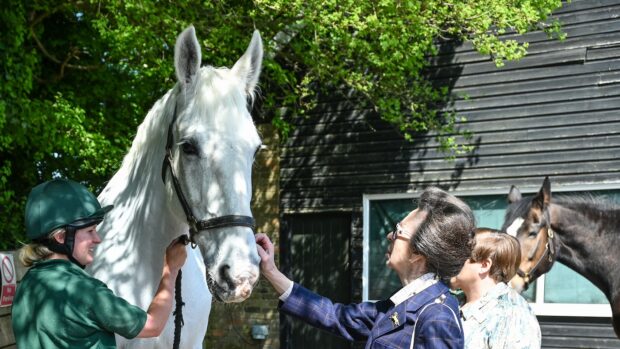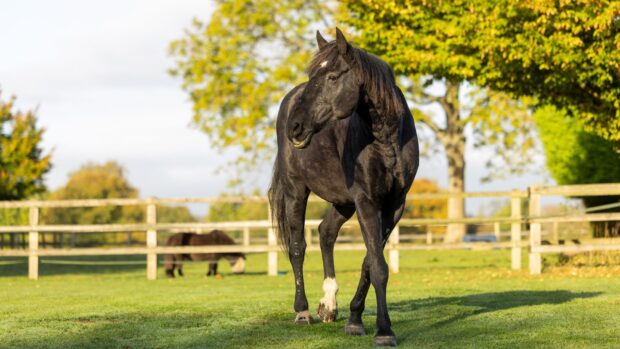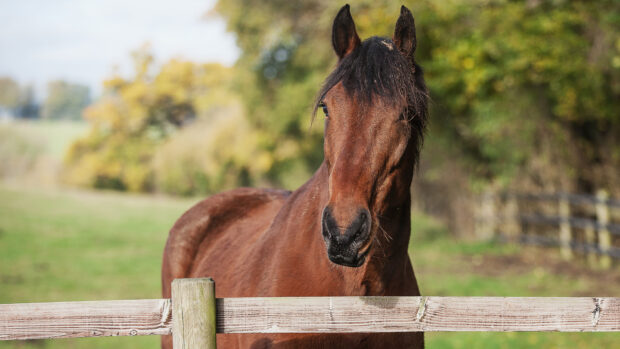Happier, healthier horses across the board was the aim of a session held as part of efforts to combat equine obesity in the UK
The Horse Trust hosted the training on 16 April as an extension of the Weigh to Win initiative, which involves giving awards to the horse or pony of the healthiest weight in showing classes across the country.
Attendees took part in interactive sessions, during which they assessed horses’ body condition scores and looked at ultrasound imaging to see where fat was deposited.
The charity’s head of research and policy Jan Rogers told H&H the event went very well, with guests from a range of societies.
“There was really good engagement,” she said, adding that the consensus was that the situation is much improved, but that there is still work to be done.
Ms Rogers said the ultrasound pictures helped convey that fat can be present and doing damage even if not visible. Delegates saw horses’ weight assessed via a tape and weighbridge, so they could see what those values looked like.
“You can use those to monitor weight changes but they don’t show where the areas of concern are,” she said, adding that the group then assessed various horses using body condition scoring, including some who were not as they seemed.
“We’ve got a retired service horse who’s a French draught, and the breed characteristically has a short neck, deep body and great depth of girth so you look and think she’s huge,” she said.
“But when you get your hands on her, you realise she’s not as big as you thought. Then we had a new intake who looks very shiny and healthy but actually has a higher body condition score, which you see when you put your hands on him and look at the fat distribution. People were amazed by the difference in what the eye sees and what’s there. It was quite eye-opening.”
Guests heard presentations on the health issues excess weight can cause, such as laminitis and strain on joints, and about the importance of language.
“It’s very easy to turn people off so it’s about finding the language that conveys the seriousness of the issue, doesn’t belittle it, but doesn’t give offence either,” Ms Rogers said. “It needs to be collaborative language, not singling people out as it’s a community problem and we all need to work on it together.”
In a group discussion that followed, Ms Rogers said “everyone agreed things have improved but there’s more to do”.
“We’ve come to normalise a high body condition score and for equine wellbeing to be improved, we need to renormalise a healthy weight,” she said. “Suggestions included some breed societies maybe incorporating some of this work in their conferences, and it was acknowledged that everyone can play a part.
“Judges and stewards can’t do it alone, vets and researchers can’t do it alone; societies and participants need to come together to help bring about positive change to horses’ wellbeing – and it’s not just showing.”
Event manager Betsy Branyan, who works on shows including the Royal Three Counties and Equifest, told H&H the training was very useful.
“It needs to be very central; one person, or one society, won’t change things alone,” she said. “My feeling is that things have got worse since judges haven’t been able to touch the animals; in showing sheep or cattle, they are felt by the judge but with horses, it isn’t part of the process, so you can’t have a real assessment of body condition, so maybe it should be part of the assessment.
“I’d love to see, not poking or prodding but something everyone can see, then the judge can say, ‘I love your horse but it’s carrying a bit too much condition.’ I think it’s worth considering.”
British Show Pony Society (BSPS) chairman Paul Cook told H&H he attended as “this is an important issue for the society”, and one that has been addressed at the BSPS judges’ conference. The BSPS has body condition scoring at its championships.
“Welfare is a critical area to be addressed, not just because it is the right thing to do, but because showing is in the public eye, with spectators, all our shows live-streamed and pictures on social media,” he said. “We need to keep moving forward and address this issue.
“We have appointed a British Horse Society welfare officer to our team, and body condition scoring forms one part of a wider welfare strategy and objectives for the BSPS in 2024. This includes how animals are looked after when staying away at our shows, how they are exercised and by whom and in lorry parks.
“This year Jan [Rogers] also presented to our members’ conference, which was well received.”
Mr Cook added that the animal in the healthiest condition may not win a class as it may not be the best; but it is one of many things judges must consider.
“My view is the next step is to widen the reach, as we often speak to the converted,” he said. “Engagement of our membership and producers and trainers across the industry, perhaps through The Showing Council is the next step.
“My ask is that this is within a wider welfare discussion, so members don’t see this as a one-issue problem, when we have other welfare issues to educate members on. We must however recognise the wider and sometimes devastating effects on an animal’s health if they are undernourished or obese.
“We also know this is not just a showing issue; it is a problem across the board.”
You might also be interested in:

‘This issue is not going away’: new measures in the fight against equine obesity

We must all unite to fight the battle against equine obesity

Not just laminitis: vets warn of performance-related issues caused by excess equine weight

Subscribe to Horse & Hound magazine today – and enjoy unlimited website access all year round
Horse & Hound magazine, out every Thursday, is packed with all the latest news and reports, as well as interviews, specials, nostalgia, vet and training advice. Find how you can enjoy the magazine delivered to your door every week, plus options to upgrade your subscription to access our online service that brings you breaking news and reports as well as other benefits.




